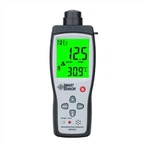How to use a digital multimeter and precautions and working principle
The multimeter consists of three main parts: the meter head, the measurement circuit and the changeover switch.
(1) Meter head: it is a high sensitivity magneto-electric DC ammeter, and the main performance index of the multimeter basically depends on the performance of the meter head. The sensitivity of the head refers to the DC current value flowing through the head when the pointer of the head is deflected at full scale, the smaller this value is, the higher the sensitivity of the head is. The greater the internal resistance when measuring voltage, the better its performance. There are four scales on the head of the meter, their functions are as follows: the first one (from top to bottom) is marked with R or Ω, indicating the value of the resistance, the conversion switch is in the ohms, i.e., read this scale. The second marked with ∽ and VA, indicating the AC and DC voltage and DC current values, when the transfer switch in AC and DC voltage or DC current block, range in addition to AC 10V other than the other position, that is, read this scale. The third is labelled with 10V, indicating the AC voltage value of 10V. When the changeover switch is in the AC or DC voltage block and the range is at AC 10V, this scale is read. The fourth bar is marked with dB, indicating the audio level.
(2) Measurement line
Measurement line is used to convert a variety of measured to the appropriate meter to measure the tiny DC current circuit, which consists of resistors, semiconductor components and batteries
It can be a variety of different measurements (such as current, voltage, resistance, etc.), different ranges, after a series of processing (such as rectification, shunt, voltage, etc.) into a certain limit of the tiny DC current into the meter head for measurement.
(3) switch
Its role is to select a variety of different measurement lines to meet the requirements of different types and different ranges of measurement. Transfer switch generally have two, respectively marked with different gears and ranges.
The use of multimeter
(1) Familiar with the significance of the symbols on the dial and the main role of each knob and selector switch.
(2) Make mechanical zeroing.
(3) According to the type and size of the measurement, select the gear and range of the change-over switch and find out the corresponding scale.
(4) Select the position of the meter pen jack.
(5) Measuring voltage: Select the range when measuring voltage (or current), if you use a small range to measure a large voltage, there is a danger of burning the meter; if you use a large range to measure a small voltage, then the pointer deflection is too small to read. Range selection should try to make the pointer deflection to about 2/3 of the full scale. If the size of the measured voltage is not clear in advance, the highest range stop should be selected first, and then gradually reduced to the appropriate range.
Precautions for use
a If the size of the measured voltage or current cannot be estimated in advance, it should be set to the highest range stop to measure once, and then gradually reduce the range to the appropriate position according to the situation. When the measurement is finished, the range switch should be set to the highest voltage block and the power should be switched off.
bWhen the full range, the instrument only displays the number "1" in the highest position, the other positions are disappeared, then you should choose a higher range.
c When measuring voltage, the digital multimeter should be connected in parallel with the measured circuit. When measuring current, the digital multimeter should be connected in series with the circuit to be measured, and it is not necessary to consider the positive and negative polarity when measuring direct flow.
dWhen the AC voltage block is mistakenly used to measure the DC voltage, or DC voltage block is mistakenly used to measure the AC voltage, the display will show "000", or the number on the low position appears to jump.
e It is forbidden to change the range when measuring high voltage (above 220V) or high current (above 0.5A) to prevent arcing and burning of the switch contacts.
fWhen " ", "BATT" or "LOW BAT" is displayed, it means the battery voltage is lower than the working voltage.






